Every motorcyclist no matter beginner or advanced must have an appropriate helmet.
Choosing the best helmet is a key factor because it keeps the most important part of the body save- the head.
I am sure you all know cases when wearing a helmet has been neglected and the result has been fatal. Really sad because it could only be a chafed knees and elbows.
That is why we will give you everything we know from our own experience, as well as everything we have learned throughout the years to help you choose the best motorcycle helmet.
Important Factors When Choosing The Best Helmet
What you need to understand is that there is no helmet that can fully meet your needs and demands.
That is why the two most important factors that are determining must be – needs and budget.
Types Of Motorcycle Helmets
The manufacturers of helmets have divided the user needs into five main groups.
- Racing (Supersport) helmets
- Touring helmets
- Urban (Commuting) helmets
- Cruisers and Customs helmets
- Off road (Dirt bike) helmets
1. Racing (Super Sport) Helmets
The general rule is that the racing helmets are noisy.
Overall, racing products are thought to be used on the track rather than on the road. That is why they work better in the environment for which they are intended.
The riders of sports bikes have one of the most colorful (literally and figuratively) choices of helmets.
With the high speed comes the increased risk of an accident. Therefore, here the maximum protection is an essential factor.
You do not just want a fast bike, but you also want a motorcycle helmet that also looks fast.
Full Face Helmets
The best choice here which covers the entire head is a “full face” helmet (also known as Integral – complete integrated head protection) for several reasons.
Full-face protection is uncompromising.
It is true that when the weather is hot, your face would be sweating and standing on the traffic light, you suddenly begin to imagine how your brain literally starts to boil.
As a rule, full face helmets give us a wider choice of visors, color and ventilation systems, many of which are really effective when driving your bike.
If you plan to spend more time riding at high speed, this helmet is the perfect choice for you.
The main features of a good racing helmet are:
- Fits and feels tight
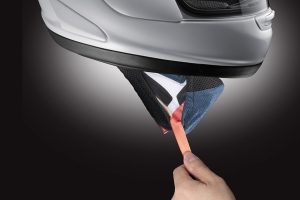
- It’s lightweight
- It has a very effective aerodynamic design
- Very good ventilation
- Some hi-end models have “emergency pull up” or cord, which in need will remove the side pads and remove the helmet easily
- Aggressive design and shades
- Opportunity to wash/ clean the inside part (those of you who have been on the track will understand why this is important)
- High price (very often you pay a high price because of the brand)
2. Touring Helmets
Touring products are made for a very wide range of users. A tourist biker could be anyone from those who are riding scooters up to those with 1 000 cc supersport machines.
Touring riders are determined by the driving style and not by the machine they have.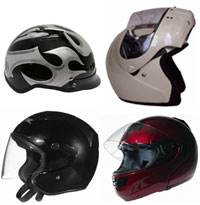
During excursions, we mostly need a long-lasting riding comfort including the one that the helmet gives us.
A full face helmet is not necessarily required especially if you are comfortably sitting behind the glass of Honda Gold Wing or Harley Electra Glide.
Just keep in mind that Touring helmets offer a relatively low level of protection compared to the Racing helmets.
The so-called “open face” helmets are just the right choice for easy riding on excursions.
This design allows easy installation of a microphone, headphones, and hands-free for communication and entertainment.
A touring helmet must meet the following criteria and satisfy a wide range of users:
- Comfortable and pleasant interior materials and design
- Optional: built-in sunglasses (very popular lately)
- Possibility to use a hands-free system or NCOM-like system
- Low noise
- Insulation of inlet air (ventilation)
- Affordable price
- Not so aggressive design so it can satisfy a wider range of tastes
Usually, people who would like a touring helmet, buy a racing and then are dissatisfied, and vice versa.
3. Urban (Commuting) Helmets
Very similar to the touring riding style, within the city people are much more seeking the comfort, entertainment and easy usage of the helmet.
That is why the “open face” helmet is also a very practical solution to drink a cup of coffee on the way to work.
Urban helmets are usually used every day so the comfort, practicality and the overall design are one of the most important factors here.
That is why there is an alternative between the open and the closed helmets and this is the so-called “Modular” or “Flip-up” helmets which combines the security of the closed helmets and the convenience of the “open face” helmets.
4. Cruisers and Customs Helmets
There is nothing wrong with wearing or not wearing some of the different helmets we presented above.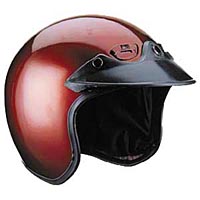
Our intention here is not to say which type of helmet is the best but rather to present them all so everyone can decide which helmet would suit him best.
But to be honest, if you are riding your Cruisers, many of you will look for minimal coverage and protection which is just enough only to pass through the Мr. Policemen’s check.
Even more than that, most cruiser riders look for something different and extravagant like the head wraps but please think twice before riding with this. Your head is totally unprotected.
Half Helmets (Shorty)
Another very popular type of helmet between the cruisers is the “Shorty” or “Half helmet”.
Not that we don’t like them but just letting you know that they cannot protect your cheeks and ears, or simply said, they offer the lowest protection among all of the other types of helmets.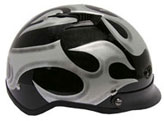
One of the main reasons cruisers like the Half helmets is because they are very easy to put on and off and also they can truly feel the nice summer breeze on their face.
However, there is always a chance that some “crazy” insects go straight into the throat but this doesn’t seem to bother them much.
It takes a lot of courage to ride with a “Shorty” during the cooler times of the year.
This shell is suitable for more relaxed riding in warm weather, riding on your Chopper or Cruiser.
5. Off-Road (Dirt bike) Helmets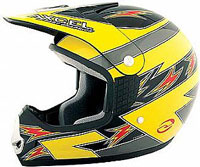
The distinctive style and design of Dirt bike helmets differentiate them from the other types we presented above.
Instead of shielding the face, they usually have a place for googles with a strap. Almost all of them have some sort of a “baseball – like” visor.
If the other helmets are so designed as to be comfortable when driving at high speed on the highway, the Off Roads are made to be used on relatively lower speed and great attention is paid on the ventilation.
Should I Buy Cheap Or Expensive Helmet
Cheaper helmets are not necessarily more unreliable compared to the more expensive ones.
The cheaper helmets are made of polycarbonate, which is a very good material for shock absorption. Ok, they have other disadvantages but still.
More expensive helmets are composite, but making a good and robust composite is not an easy task.
This means that super expensive helmets such as the Arai RX7 GP and the Schuberth SR1 have only four stars on the “Sharp” safety tests, unlike the Marushin 777, which collects 5 stars and costs 1/8 of Arai’s price.
But that does not mean that Marushin is a better helmet.
Overall, the new helmet models (from 2011) are much safer than the old ones.
For example, Shoei XR-1000 gets only 3 stars on “Sharp”, while XR-1100 gets 5, X-11 gets 4, and X-12 gets 5 stars.
Our opinion is that everything from 4 stars (and up) up is more than acceptable when choosing a helmet. We would surely not take a helmet with less than 4 stars.
Of course, you may decide not to trust “Sharp”, and that’s your right, but we believe them.
There are videos on in the web where you can see how the helmets are tested and what actually “Sharp” does.
The best when choosing a helmet is to try different models. You do not have to buy the most expensive model of a certain brand just because someone or the salesman in the shop told it is the best.
What works for others may not work for you. The first thing to consider is whether you need a touring, racing, cruiser or another model helmet.
By testing different manufacturers and models you will see which one fits best on your particular type of face – oval or elongated etc.
It is very important that the helmet fits you perfectly and you feel it comfortable.
Famous Helmet Manufacturers
Our advice when choosing a helmet is to stick to familiar names. Here are some of the most famous manufacturers:
- Shoei (Japanese company)
- Arai (Japanese company)
- AGV (Dainese Group – Italian)
- Schuberth (German company)
- Nolan group (Nolan, Grex, and X-Lite – Italian company)
- Shark (French company)
- HJC (Korean Company)
- Airoh (Italian company)
- Suomy (Italian company)
- Caberg (Italian company)
- Lazer (Belgian company)
Arai & Shoei
The two producers, competing for the title “Best Helmet Manufacturer”, are the Japanese companies Arai and Shoei.
The helmets are made entirely in Japan and have a very high quality of workmanship.
Nolan, Suomy & AGV
The other three companies, which also have a huge market share, are the Italian Nolan (X-Lite, Grex, Nolan), Suomy and AGV.
HJC
The HJC market is mainly in the United States.
Shark
Shark is a European brand that is gaining popularity because of the high quality of the helmets they produce.
Schuberth
Schuberth is a German brand that is famous for high-quality and low noise helmets. Schuberth SR1 is one of the best racing helmets on the market.
Airoh & Caberg
Airoh and Caberg are mostly oriented in the lower price segment.
Lazer
Lazer is a company based in Belgium, the helmets are in the middle price range and are of good quality.
Affordable and Quality Helmets
Other producers who until recently were not so familiar, but because of the good quality and good prices secured their place on the “first row” are:
- Icon (American brand, helmets are made in China)
- KBC (Korean company, very popular in the US)
- Scorpion (American-Korean company – manufactures the helmets in China)
- OGK-Kabuto (Japanese-Korean company, the FF5 model is great for its price – produce their helmets in China)
- Nitro (produced in the OGK factories in China. The brand is focused on the English and US markets)
- Marushin (a Japanese company bought by German producers in China)
Of course, there are other models of lesser-known manufacturers like Nexx, Bell, etc. We do not recommend that you buy such a helmet unless you have tried it and you know for sure it suits you well.
Helmet Buying Guide
More expensive helmets are made of composite materials (fiberglass and kevlar/carbon). These helmets usually come in several shell sizes.
Shoei XR-1100, for example, comes in 4 different sizes. This means that by buying size M, you get a smaller shell, which means a better fit and lighter helmet.
Weight
Keep in mind that usually the manufacturers of cheaper helmets, are lying about the helmet weight.
For example, we know a model of a cheap brand (not saying it by purpose) should weigh 1450 g +/- 50. When we weighed it, it was exactly 1550 g.
Speaking about high-class helmets, the Shoei XR-1100, size L weighs exactly 1450 g, and the size M weighs exactly 1,350 g. And that is exactly what is written on the label.
Helmet Visor Shield Attachments
Pay attention to the visor shield attachment system as this is very important for easy attach and detach for the purpose of cleaning.
Some manufacturers have very complicated systems which make it too hard and time-consuming to clean your visor.
From our experience, we can say that Shoei has a good system which is fairly easy to operate with.
Also, there are different technologies against blurring. It’s good if the visor is treated against fog or to have a double – window type system called “Pinlock”.
Proper racing helmets have a “Pinclock tear-offs” which means that when the visor is dirty, it can easily be detached while driving just by pulling. You should have seen that on MotoGP or WSBK.
Chin Curtains
Another important feature that the best helmet is good to have is the so-called “chin curtain”.
The chin curtain is especially appreciated at lower temperatures. It stops the incoming cold air over your face and it also lowers the noises.
Try Before Buy
If you are about to try some of your friend’s helmets, take your time and wear it for about 5 – 10 minutes.
This way you’ll get used to it and you will find out if this particular helmet is comfortable and the right one for you.
Try to move it by touching the part of the chin. If it fits you well, then it should move your entire head by touching your cheeks.
A big helmet will move easily around the head and a small will tighten and cause discomfort.
Wearing a wrong helmet size is dangerous!
Should I Buy A Second-Hand Helmet
You do not have to spend $ 1 000 for a quality helmet
You can still get a good quality helmet for about half the price, which is brand new.
Do not make the mistake that some of your friends will advise you to buy a used helmet which history you are not aware of.
Manufacturers recommend changing your helmet at about 5-year period, or in the event of a break-in. And there is a reason behind that!
Go to a few stores, try different models and choose a model (from a well-known manufacturer) that most suits your needs and makes you happy wearing it.
After you have chosen your model and size, you can always go and buy it online at a much cheaper price.
How Do You Measure Head For A Helmet
The exact size of the helmet can be truly life-saving. Size determination is extremely subjective and varies between brands and sometimes even between models within the same brand.
Furthermore, each motorcycle helmet carries the features of its producer and in this connection has its own specificity as to how it stands in different head forms.
Some brands are better suited for circular-shaped heads, others for oblong ones. Therefore, here are some tips for defining the right motorcycle helmet size.
Head circumference measurement
The best way to measure your head is by using a plastic tape measure.
Place the tape measure about 5.9 inches above the eyebrows (about one finger) and make a circle in a straight line that is slightly above the ears.
In any case, you should fit in the range of 20-25 inches, i.e. size from XXS to XXL.
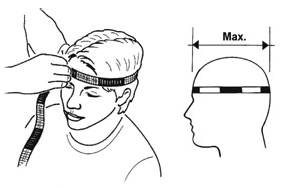
Helmet Size Chart
When you know the exact size of your head, choose the corresponding helmet size from the chart below.

Important Note
There are quite a few differences between fake helmets and certified ones, but one of the most important is the use of ESP (Expanded Polystyrene) foam.
It is this foam that absorbs the energy of an impact. Being hit, the foam gets creased.
It is not elastic, as opposed to the rubber filling that provides the comfort of the helmet.
Once crushed, the foam has lost its energy-absorbing capacity, which is why the helmet has to be changed.

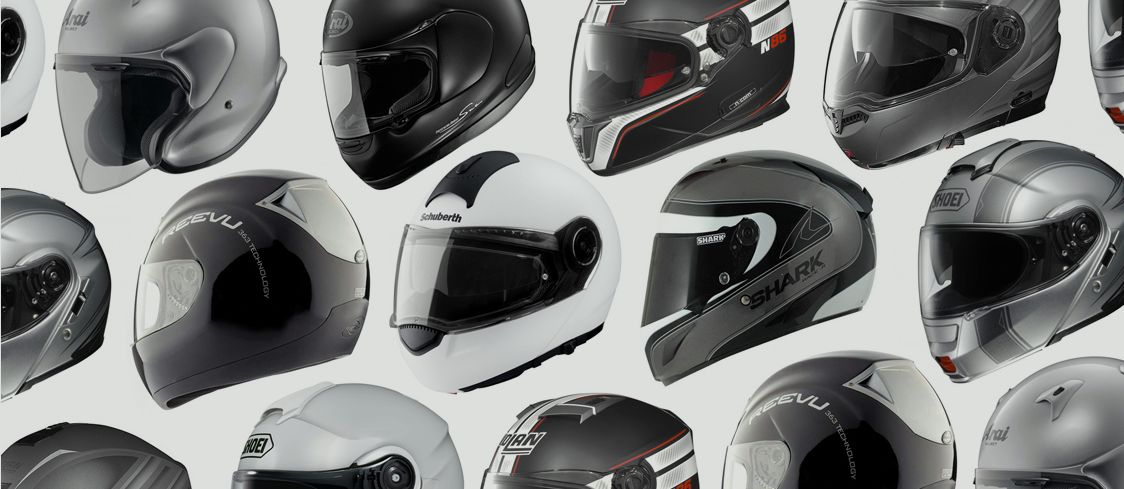
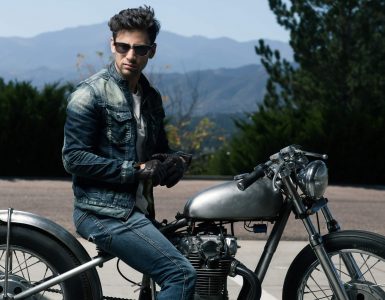
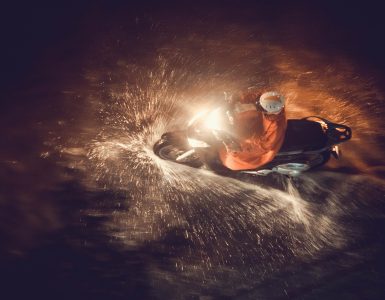















Your helmet size chart has helped me a lot.
Thanks for your service.